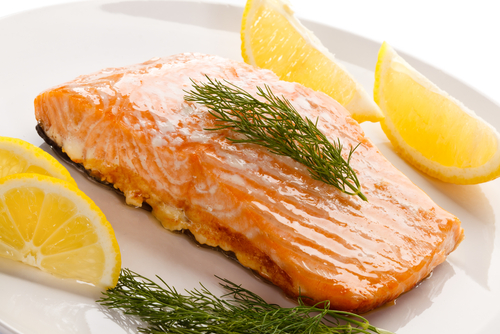If you’ve read this blog before, then you know how important omega-3 fatty acids are for your health. You probably have also learned that salmon is one of the absolute BEST sources of omega-3s.
But not all salmon is created equal. Much of the salmon available at your local grocery store was not caught in the wild but instead bred in fish farms. You may have heard wild caught fish is better for your health but is this true?
We’ll explore the differences between farmed salmon and wild salmon to discover if one is healthier for you.
Let’s dive in.
Difference #1: Sourced from Very Different Environments
As the name suggests, wild salmon is caught in the wild, meaning the fish live and grow in their natural habitats of oceans, rivers and lakes.
Farmed salmon, which accounts for roughly half of the salmon sold worldwide, uses a process known as aquaculture to breed fish for human consumption. While wild salmon are able to eat other organisms found in their natural surroundings, farmed salmon are fed processed, high-fat, high-protein feed in order to produce larger fish. This difference in diet has an effect on the nutritional value of the fish you eat, much like grass fed cattle (a natural diet) offer a different nutritional profile than grain-fed cattle.
How big of a difference does this amount to? Let’ have a look…
Difference #2: Nutritional Value
So now you now know that farmed salmon is fed processed food whereas wild salmon eats a natural diet of various invertebrates. This can significantly change the nutritional value of the fish you eat.
Below is a table of information that outlines the sometimes vast differences between the nutritional value of farmed vs wild salmon.
| 1/2 fillet wild salmon (198 grams) | 1/2 fillet farmed salmon (198 grams) | |
| Calories | 281 | 412 |
| Protein | 39 grams | 40 grams |
| Fat |
13 grams |
27 grams |
| Saturated fat | 1.9 grams | 6 grams |
| Omega-3 | 3.4 grams | 4.2 grams |
| Omega-6 | 341 mg | 1,944 mg |
| Cholesterol | 109 mg | 109 mg |
| Calcium | 2.4% | 1.8% |
| Iron | 9% | 4% |
| Magnesium | 14% | 13% |
| Phosphorus | 40% | 48% |
| Potassium | 28% | 21% |
| Sodium | 3.6% | 4.9% |
| Zinc | 9% | 5% |
There are some very clear differences between farmed and wild salmon. But the number I want you to pay close attention to is the omega-6 value. The farmed salmon has significantly more omega-6 than the wild salmon. Why does this matter?
Omega-3s are great at reducing inflammation throughout the body. This is why they are so effective in helping people with diseases like arthritis.
But omega-6s can CAUSE inflammation in the body. And if you have too many omega-6s compared to omega-3s, you’re setting yourself up for an inflammatory response.
So the fact that farmed salmon has FAR MORE omega-6s than omeg-3 is not great if the whole point of you eating salmon is to get more omega-3s into your diet and reduce inflammation. For this reason alone, wild salmon wins hands down. But let’s keep digging to see what other differences we can come up with.
Difference #3: Farmed Salmon May Contain More Contaminants
Studies have shown that farmed salmon has much higher concentrations of contaminants than wild salmon. These contaminants typically include polychlorinated biphenyls (PCBs), dioxins and several chlorinated pesticides.
Of these the most dangerous are PCBs, which have long been associated with cancer and other health issues. And studies have shown that PCB concentrations in farmed salmon are 8 times higher than in wild salmon. For this reason, researchers suggest if EPA (environmental protection agency) guidelines were applied to farmed salmon, consumers would be encouraged to restrict eating salmon to no more than ONCE A MONTH!!
Difference #4: Antibiotics in Farmed Salmon
Farmed fish are not raised in the nicest of environments. They are usually packed into small tanks, which often leads to numerous infections. To counter this problem, antibiotics are frequently added to farmed fish feed.
There is also the problem of unregulated and irresponsible use of antibiotics in developing nations. So, depending on where the food manufacturer sources its fish, you may have extra trouble on your hands.
Of course, all of these antibiotics winds up in your body, where they can wreak havoc on your gut’s microbiome, which can ultimately lead to a host of health issues for you.
The Bottom Line
When you take a look at these differences it’s easy to see that wild caught salmon really is the way to go. It provides a better nutritional profile, and less dangerous contaminants and antibiotics.
Having said that, wild caught salmon is more expensive than farmed salmon and, depending on your budget, it may simply not be an option for you.
So what do you do then? Well, if your goal is to get more omega-3 fatty acids into your diet, then we recommend relying on a quality omega-3 supplement. But just as not all salmon is created equal, not all fish oil supplements are created equal either.
Many come with the same problems of contaminants and impurities.
That’s why Primal Labs worked hard to come up with our own omega-3 supplement for our readers.
Our DuOmega 3&7 is pure, potent and has something not many other fish oil supplements on the market have – and that’s added Omega-7! Only omega-7 offers heart health benefits. Combined with Omega-3, our DuOmega is a powerful and affordable way to reduce inflammation, protect your heart and stay healthy! Click Here for all the info.
 Validating...
Validating... 





Leave a Reply